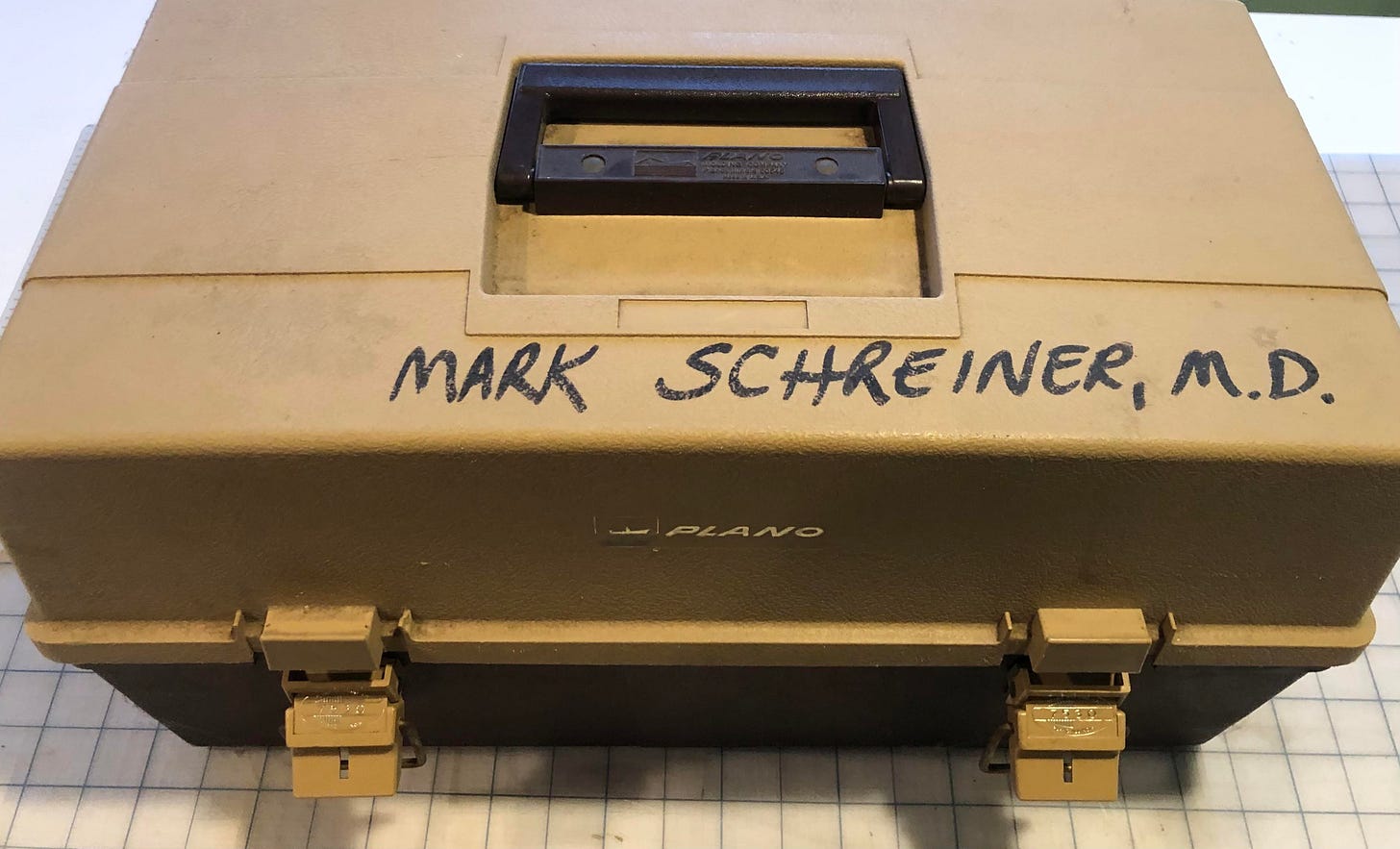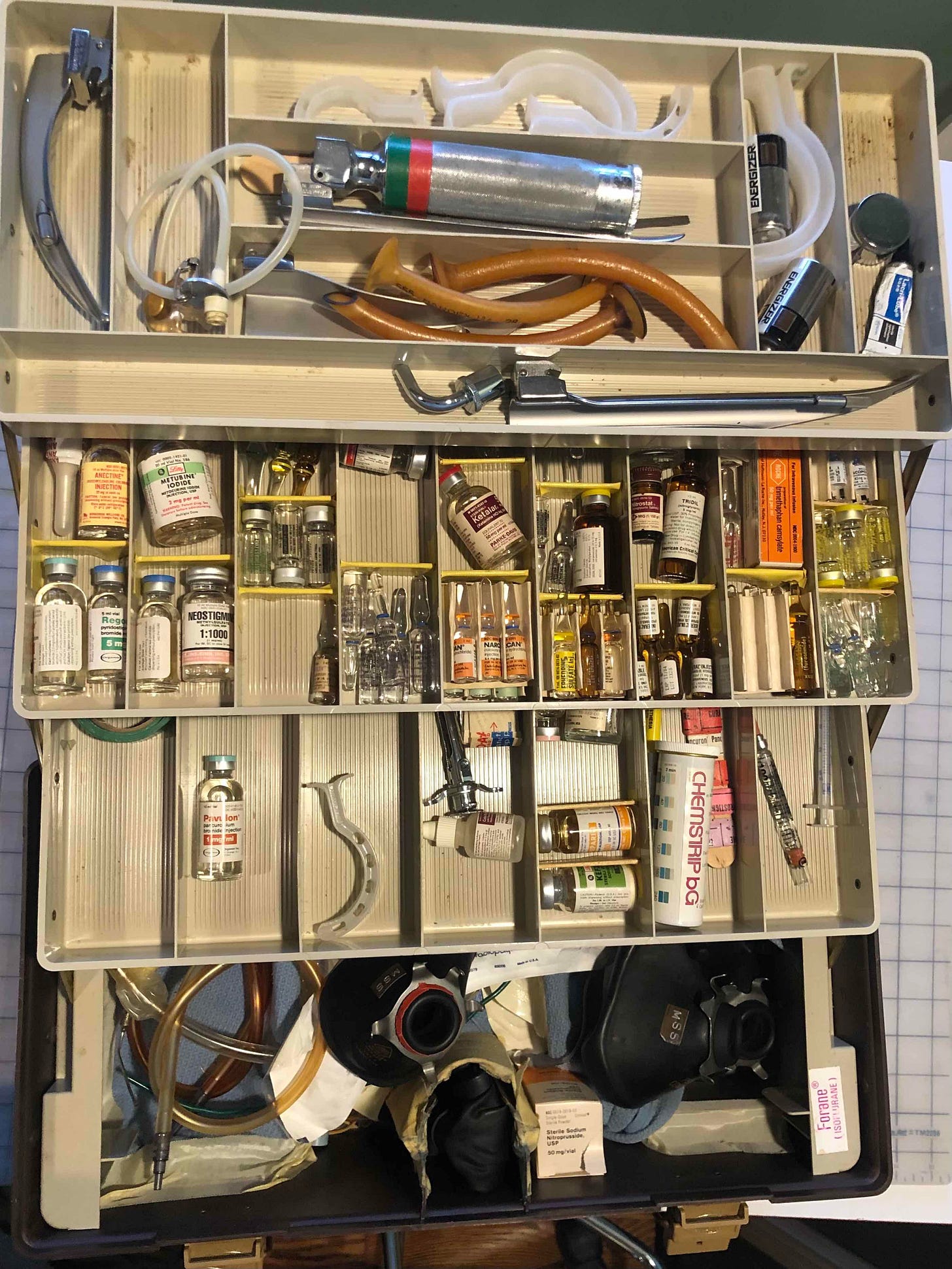From Mark Schreiner MD on Disposable laryngoscope handles and blades
I read today’s PAAD (March 27, 2024) with interest and reflected on my experience as an anesthesia resident at the Hospital of the University of Pennsylvania in 1981.
We were issued a tackle box with a laryngoscope, a Miller 3 blade, a Mac 3 blade, a set a face masks, an esophageal stethoscope, a transport bag, and oral and nasal airways. We were also issued a blood pressure cuff but most residents bought an oscillotonometer since it was impossible to use a standard BP cuff in a noisy OR. We were expected to gather whatever drugs we might need from the storeroom since the rooms were sparsely stocked. My box was continually evolving (with “found" useful items mostly extra blades) and obsessively organized.
We washed whatever equipment we used in the scrub sink after each case. Depending on how fastidious we were, the washed equipment was more or less clean but nothing was ever sterilized. I used the same laryngoscope blades, esophageal stethoscope and airways daily for all my cases as a resident at HUP. (At CHOP, the VA, and other outside hospitals the OR rooms were fully equipped and cleaned by technicians) I shudder to think what harms befell our patients as a result of this practice.
PS: From Myron: We also washed our anesthesia circuits and used the same black hoses for years. There were no disposable circuits. No…. disposable…. circuits….. (shudder).
From Chelsea Vitu MD, Assistant professor, Medical university of South Carolina on plastics
I have a lot of thoughts about this but I will try to condense them. No one actually cares about plastics. If we were actually scared we would have a formal government-driven plan to phase them out. But plastics are ubiquitous and enmeshed in how we live. For example: Saran wrap, Tupperware, a lot of our medical equipment. Don’t get me started on the single use laryngoscopes, etc., packaging, commercially available slow release fertilizer granules. (I mention this because one of the booming hobbies after COVID was gardening)
I DO think that we all can takes steps to decrease our use and hopefully decrease manufacture of them as well. Unfortunately, recycling has proven itself to be a way we soothe ourselves but is otherwise not fixing the problem.
1. Awareness has probably been achieved but doesn’t feel like it’s actionable because there are no alternatives to plastic that are easily available.
2. Reduce use- I think this could be huge. Why are my scrubs packaged in plastic bags ?? We can also be more mindful of what equipment is opened for a case.
3. Change the system- the hardest so far. It feels like hospital systems are moving towards single use items for multiple reasons whether it’s for cost or because of difficulties with infrastructure relating to reprocessing. There is data that reusable items create less waste. In certain circumstances (ie more austere areas), the water used to reprocess items may be an issue, and single use items may be more appropriate there.
I am certainly not an environmental warrior or someone who mandates absolutely no use of plastic. In our current environment, zero plastic use is impossible. But I think it is entirely reasonable, doable, and responsible to do the things above.
From Tokiko Kushiro-Banker, BVM, MS, PhD, Dipl. ACVAA (she/her/hers), Associate Professor of Anesthesiology, Department of Specialty Medicine, College of Veterinary Medicine, Midwestern University, Glendale, AZ 85308 on drug error.
I am a veterinary anesthesiologist and there are more similarities than differences in our practices. We also experience drug administration errors because of misread drug labeling and preparation. Although this is late to reply, here possibly the simplest way I always do to prevent picking wrong drug syringes. A simple technique that I use and teach my trainees that makes syringe labeling more “readable” from any angle can be seen in the picture below. I place the label 360 degree of the syringe barrel, at or close to the bottom of the barrel above the flange, so that the label won’t hide the scale. I purposefully make a tab/flap to make it even more obvious to read the actual drug name, especially on small size syringes such as insulin syringes, 1-mL syringes, or 3-mL syringes (or even larger ones). Especially in emergency/critical situations, trying to find which syringe is the exact one I need out of 5+ other syringes is truly frustrating, inefficient, and possibly detrimental to patients, yet very easily avoidable.






